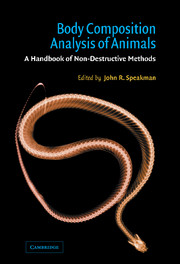Book contents
- Frontmatter
- Contents
- List of contributors
- Preface
- Acknowledgements
- Introduction
- 1 Morphological indicators of body condition: useful or wishful thinking?
- 2 Standard methods for destructive body composition analysis
- 3 The isotope dilution method for the evaluation of body composition
- 4 Gas dilution methods: elimination and absorption of lipid-soluble gases
- 5 The use of total body electrical conductivity (TOBEC) to determine body composition in vertebrates
- 6 The use of bioelectrical impedance analysis (BIA) for estimation of body composition
- 7 The assessment of body composition and other parameters by ultrasound scanning
- 8 The use of dual-energy X-ray absorptiometry for the measurement of body composition
- Index
7 - The assessment of body composition and other parameters by ultrasound scanning
Published online by Cambridge University Press: 19 January 2010
- Frontmatter
- Contents
- List of contributors
- Preface
- Acknowledgements
- Introduction
- 1 Morphological indicators of body condition: useful or wishful thinking?
- 2 Standard methods for destructive body composition analysis
- 3 The isotope dilution method for the evaluation of body composition
- 4 Gas dilution methods: elimination and absorption of lipid-soluble gases
- 5 The use of total body electrical conductivity (TOBEC) to determine body composition in vertebrates
- 6 The use of bioelectrical impedance analysis (BIA) for estimation of body composition
- 7 The assessment of body composition and other parameters by ultrasound scanning
- 8 The use of dual-energy X-ray absorptiometry for the measurement of body composition
- Index
Summary
Introduction
Ultrasound has been employed in various technologies. It is a tool for civil and military marine location and navigation (SONAR, Sound Navigation and Ranging), and is also used for quality control in material sciences, and as a non-invasive tool for diagnostic imaging in human and veterinary medicine. Evolution has made use of ultrasonic physical phenomena, and many animals use ultrasound for orientation and communication, e.g. bats, whales, small mammals, some birds.
The physical principle underlying all ultrasound applications, technical and biological, is basically the same: a very high frequency sound is emitted from a source and travels some distance through a medium until it hits a reflector that returns it as an echo to its source. Time differences between sound emission and the returning echo, and the intensity of the echo may be used to obtain information about distance and about the properties of the reflector. It depends on the computational procedure whether the echo information is employed to give local information, navigational cues, or to produce images.
This chapter is about imaging, and we leave ranging and navigation for other discussions. Ultrasound imaging was developed in the 1950s to provide a diagnostic tool in human medicine (Morneburg, 1995). Much progress has been made since the late 1960s, when advanced algorithms and computer technologies allowed for faster data processing and real time imaging. Today, ultrasound imaging is a pivotal diagnostic tool in almost all fields of human medicine, and has gained increasing importance in veterinary medicine and reproductive management (Göritz, 1993; Hildebrandt et al., 1998). However, it is still a rather rare tool in zoological and ecological research.
- Type
- Chapter
- Information
- Body Composition Analysis of AnimalsA Handbook of Non-Destructive Methods, pp. 188 - 210Publisher: Cambridge University PressPrint publication year: 2001
- 9
- Cited by



